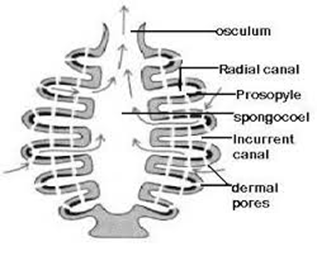Overview On Phylum Chordate - Biology Blog
 Phylum Chordata
Phylum Chordata
- dorsal, hollow nerve cord – becomes the brain
- spinal cord notochord - flexible, fibrous rod along the back (replaced by vertebrae in advanced vertebrates)
- pharyngeal gill slits - openings in the throat region.
- postanal tail – most other animals with tails near the anus have anus at end of the tail. These features may each be lost or altered in the adult.
This phylum has three subphyla:
1. Cephalochordata,
2. Urochordata, and
3. Vertebrata
1. Subphylum Cephalochordata (clade) – lancelets
- fishlike creatures that bury selves in mud and filter feed
- all four key chordate feature present in adults
- like vertebrates, muscles broken up into bands called myomeres (body segmentation)
- essentially no brain in adults
2. Subphylum Urochordata (clade) – sea squirts, tunicates
- Barrel-shaped, sessile, filter-feeders
- Many secrete and live in a tough cellulose sac (tunic) as adults
- Oly have pharyngeal gill slits as adults, other chordate characters only present in tadpole-like larvae
- Incurrent and excurrent siphons
- No brain in adults
3. Subphylum Vertebrata (clade)
- More properly called Craniata (read on and see if you can figure out why)
- Head with brain and skull
- Vertebral column – during development in most (all but Myxini), surrounding and ultimate replacement of notochord by bony or bone-like, hollow vertebrae; also, encase brain in the protective box (skull or cranium) of bone or cartilage
- Neural crest ectoderm – a unique set of stem cells that form near the neural tube and migrate during development, involved in forming a variety of structures
- Highly developed internal organs
- Unique kidney and excretory system
- Endocrine glands (make many hormones)
- Specialized heart; closed circulatory system
- Endoskeleton made of cartilage and/or bone
- Cartilage and bone are tissues with compacted collagen protein fibers
- Collagen matrix laid down first (provides flexibility)
 For bone, calcium phosphate is then deposited (provides rigidity)
For bone, calcium phosphate is then deposited (provides rigidity)- Better than chitin – strong but not brittle (if you get enough calcium)
living craniates in eight main classes
four considered fishes (Myxini, Cephalaspidomorphi, Chondrichthyes, and Osteichthyes)
four considered tetrapods (arose from fish; Amphibia, Reptilia, Aves, and Mammalia)
I. Fishes
- Aquatic vertebrates that lack pentadactyl (5-fingered) limbs
- Over half of all vertebrates; evolutionarily, the first vertebrates
- Gills – water comes through the mouth and goes out throat slits covered with small blood vessels
- (capillaries); blood flow goes opposite water flow to maximize gas exchange
- Single-loop blood circulation: heartàgillsàrest of bodyàheart
 A. Superclass – Agnatha (without jaw) Class – Cyclostomata
A. Superclass – Agnatha (without jaw) Class – Cyclostomata - All living members
- ectoparasites on some fishes.
- They have elongated bodies bearing 6-15 pairs of gill slits for respiration.
- Cyclostomes have a sucking and circular mouth without jaws.
- Their body is devoid of scales and paired fins.
- Cranium and vertebral column are cartilaginous.
- Circulation is of closed type.
- Cyclostomes are marine but migrate for spawning to freshwater. After spawning, within a few days, they die. Their larvae, after metamorphosis, return to the ocean.
Examples: Petromyzon (Lamprey) and Myxin
B. Superclass - Gnathostomata (with jaw)
- · Jaws are present
- · Paired lateral appendages
a. Class Chondrichthyes – cartilaginous fishes; sharks, skates, rays
- They are marine animals with a streamlined body and have a cartilaginous endoskeleton
- The mouth is located ventrally.
- The notochord is persistent throughout life.
- Gill slits are separate and without operculum (gill cover).
- The skin is tough, containing minute placoid scales.
- Teeth are modified placoid scales that are backwardly directed.
- Their jaws are very powerful.
- These animals are predaceous.
- Due to the absence of air bladder, they have to swim constantly to avoid sinking.
- The heart is two-chambered (one auricle and one ventricle).
- Some of them have electric organs (e.g., Torpedo) and some possess poison sting (e.g., Trygon).
- They are cold-blooded (poikilothermous) animals, i.e., they lack the capacity to regulate their body temperature.
- Sexes are separate.
- In males pelvic fins bear claspers.
- They have internal fertilization and many of them are viviparous.
Ex. Scoliodon (Dogfish), Pristis (Sawfish), Carcharodon (Great white shark), Trygon (Stingray).
 b. Class Osteichthyes (clade) – bony fishes
b. Class Osteichthyes (clade) – bony fishes- Swim bladder
- An internal structure filled with air (usually via gases released from blood)
- Amount of air can be adjusted, used to regulate body density and thus depth in water derived from lung, a primitive structure used to breathe air
- Lateral line system
- Found in other jawed fishes, but most prominent in bony fishes
- System of pores along the body
- Used to sense vibrations in water; both moving and still, objects can be detected
- Operculum or gill cover
- Allows greater diversity in food capture and preparation
- Increases breathing effectiveness (throat muscles aid in breathing)
- Can breathe without swimming, unlike sharks
Examples: Marine – Exocoetus (Flying fish), Hippocampus (Sea horse); Freshwater – Labeo (Rohu),
Catla (Katla), Clarias (Magur); Aquarium – Betta (Fighting fish), Pterophyllum (Angelfish).
The remaining part will be uploaded in the next blog.










Comments
Post a Comment